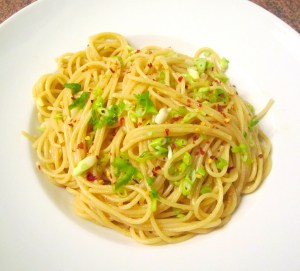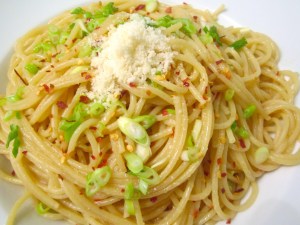.
Tonight,
a simple, great, straightforward pasta dish is all I need.
I give you : Spaghetti aglio e olio 🙂
.
.

.
.
Ingredients :
- 1 pound dried Spaghetti
- 1/2 cup extra-virgin olive oil
- 2 tablespoons roasted garlic
- 1 tablespoon crushed red pepper flakes
Salt, to taste
Method :
Cook pasta in boiling, salted water until al dente.
Meanwhile, heat olive oil in a saucepan over medium heat.
Add garlic and red pepper flakes and cook until garlic is fragrant.
Drain pasta, reserving some of the cooking liquid. Add to pan.
Season with salt.Mix well, adding some of the cooking liquid
if the pasta seems too dry.
To serve, sprinkle with chopped italian parsley.
Please note :
I have changed the basic, very traditional recipe by replacing
slivered garlic with roasted garlic and adding scallions
(for crunch) and Parmigiano Reggiano (for taste).
Buon Appetito ! Life is Good !
.
.







Hi Chef, sorry I haven’t been around lately. Trying to keep my head above water. So great to your blog again, miss you, and hope you are well. Take care Chef Carpenter
LikeLike
Please there is a BID tast differemce between Parmiggiano and “Parmesab.”
LikeLike
Big difference Parmiggiano Reggianno and Parmesan
LikeLike
Yes George, that’s pretty clear to us professionals.
That is why if I use Parmigiano-Reggiano I say so, and when I use simple Parmesan I say so too.
Please note that there is some pretty crappy parmesan and there is also some pretty good Parmesan out there 🙂
I use a lot of cheese every month (probably 2to 3 lbs a week) and to use only the most expensive all the time is just too expensive sometimes.
However, for those who need the info, here it is :
Question: Parmesan vs Parmigiano
What is the Difference Between Parmesan and Parmigiano-Reggiano?
Answer: Due to Italian D.O.C. laws that protect the names and recipes of certain cheeses, a cheese cannot be called Parmigiano-Reggiano unless it is made using a specific recipe and production method within the provinces of Parma, Reggio-Emilia, Modena, and specific regions in the provinces of Bologna and Mantua. The D.O.C laws are meant to preserve the integrity of traditional cheeses by insuring the flavor and quality. Therefore, any cheese made outside of these regions with a slightly different recipe or production method cannot be called Parmigiano-Reggiano.
Parmesan is often thought of as an English version of the word Parmigiano-Reggiano, but it goes deeper than that. If a cheese is labeled as Parmesan, it is also a cheese that imitates the recipe for Parmigiano-Reggiano, but is made without following the D.O.C. laws. Typically, a cheese labeled as “parmesan” has not been made in Italy. Within Italy, cheeses that imitate Parmigiano-Reggiano are called Grana, which means “granular” and refers to the texture. An example is the cheese Grana Padano.
LikeLike